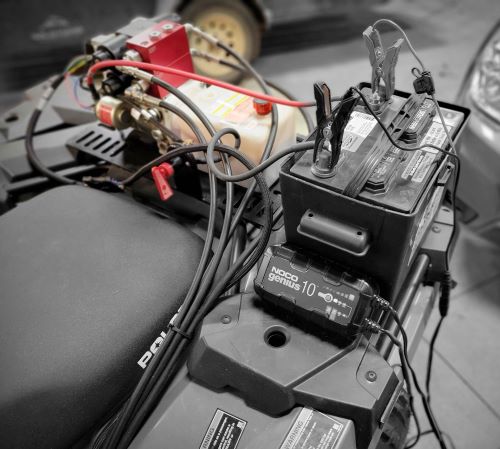
Introduction:
12-volt battery chargers have made huge strides over the past decade or two. They are crucial to keeping your batteries running for years and in tip top shape. Years ago, the only type of battery charger available was a manual charger that you’d attached to the battery, monitored the charger’s amp meter until it reached near zero, and then unplugged it or turned it off. The amp meter would start out reading at the amperage of the charger and continue to force amps into the battery until it was full and the amp meter read near to zero. If you left the battery charger on too long or weren’t paying attention, it would result in overcharging, and you could severely shortening the battery’s life or ruin it altogether.
Understanding battery types, and the technologies available are very important. The following describes battery charger types, technologies, and applications. With this information, you will be equipped to make an informed decision.
Types of 12-Volt Battery Chargers:
Manual Chargers: Manual chargers require the user to monitor the charging process and disconnect or shut off the charger once the battery is fully charged. These chargers are generally less expensive and straightforward, making them suitable for those who prefer a hands-on approach. However, it’s essential to be vigilant during the charging process to avoid overcharging, which can damage the battery.
Automatic Chargers: Automatic chargers, also known as “smart” chargers, are designed to monitor the battery’s condition and adjust the charging rate accordingly. They typically feature microprocessor technology that can detect the battery’s state of charge and adjust the voltage and current accordingly. This makes automatic chargers user-friendly and safe, as they reduce the risk of overcharging. They are suitable for various applications, from automotive batteries to deep-cycle batteries such as those used on the Wild Hare ATV Implement System.
Choosing the Correct 12-Volt Charger:
Selecting the right 12-volt battery charger involves considering several factors:
- Battery Type: Different batteries have specific charging requirements. Ensure the charger you choose is compatible with the type of battery you’re working with, whether it’s a standard lead-acid battery, a deep-cycle battery, or an AGM battery. Please refer to our previous blog or consult the battery manufacturer’s website or manual.
- Charging Speed: Consider the charging speed based on your needs. High amperage chargers can recharge a battery quickly but may not be suitable for long-term maintenance. Slower chargers, such as trickle chargers, are better for maintaining a battery’s charge over an extended period.
- Voltage: Match the charger’s voltage with the battery’s voltage. Using the wrong voltage can damage the battery and compromise its performance. Use only a 12-volt charger on a 12-volt battery.
Traditional Chargers vs. Smart Chargers vs. Trickle Chargers:
Traditional Chargers: Traditional chargers deliver a constant charge rate throughout the charging process. While they are effective, they require careful monitoring to prevent overcharging. These chargers are suitable for users who are actively engaged in the charging process and are willing to disconnect the charger once the battery is fully charged.
Smart Chargers: Smart chargers, equipped with advanced technology, can adjust the charging parameters based on the battery’s condition. They are efficient, safe, and user-friendly, making them an excellent choice for those who want a hands-off approach to battery charging. Smart chargers are particularly useful for batteries in vehicles that may sit idle for extended periods. Newer, more advanced chargers can even bring old batteries back to life with a process known as desulfating (please see 2 paragraphs below).
Trickle Chargers: Trickle chargers provide a low amp (1-2 amps), constant charge, ideal for maintaining a battery’s charge during storage. They are designed to prevent self-discharge and battery depletion over time. While not suitable for rapid charging, trickle chargers are invaluable for keeping batteries in top condition during long periods of inactivity, such as winter storage for vehicles and boats.
Desulfating – A New Era of Battery Chargers
Sulfation occurs when lead sulfate crystals build up on a battery’s plates, hindering the chemical reactions that generate electrical energy. This buildup is a natural byproduct of the discharge and charge cycles batteries go through. Over time, if not addressed, sulfation can lead to reduced capacity, longer charging times, and ultimately, premature battery failure.
Advantages of 12-Volt Desulfating Battery Chargers:
Revitalizing Performance: Originally developed for the United States Military, the primary purpose of desulfating battery chargers is to break down and dissolve lead sulfate crystals that have formed on the lead battery plates. By doing so, these chargers can revitalize the battery, restoring its capacity and overall performance. This is particularly beneficial for older batteries that may have experienced a decline in efficiency.
Extended Battery Life: One of the most significant advantages of desulfating chargers is their ability to extend the life of lead-acid batteries. By actively addressing sulfation, these chargers help prevent the buildup of crystalline deposits, slowing the aging process of the battery. This can result in a longer service life and reduced frequency of battery replacements, saving both money and resources.
Improved Charge Acceptance: Sulfation not only reduces a battery’s capacity but also hinders its ability to accept a charge efficiently. Desulfating chargers enhance the charge acceptance of batteries by going through a preprogrammed high amperage and low amperage battery recovery cycle that breaks down lead sulfate crystals, allowing the battery to charge more effectively. This is crucial for maintaining optimal performance, especially in applications where reliable and quick recharging is essential. It is often capable of bringing dead batteries back to life.
Maintenance Charging: 12-volt desulfating battery chargers often include maintenance or float charging capabilities. This feature allows the charger to provide a low, constant charge to the battery, preventing self-discharge and sulfation during periods of inactivity. This makes them ideal for applications like the Wild Hare ATV Implement System, seasonal vehicles, boats, or backup power systems.
Cost-Effective Solution: While desulfating battery chargers may come at a slightly higher initial cost compared to standard chargers, their long-term benefits make them a cost-effective solution. The extended life of batteries and the reduction in premature replacements contribute to significant savings over time.
Environmentally Friendly: By extending the life of batteries, desulfating chargers contribute to a reduction in the environmental impact associated with battery disposal. Fewer discarded batteries mean less hazardous waste in landfills, aligning with a more sustainable and eco-friendly approach to battery maintenance.
Conclusion:
If your battery charger is over 10 years old, you may want to look at upgrading or at least researching new charging technologies. Choosing the right 12-volt battery charger involves understanding your specific needs and the characteristics of the battery you’re working with. Whether you opt for a manual charger for hands-on control, a smart charger for convenience, or a trickle charger for long-term maintenance, ensuring compatibility and understanding the charging process is crucial. Pay special attention to desulfating battery chargers as they can be a huge improvement over traditional chargers. Armed with this knowledge, you can make an informed decision to keep your batteries charged and ready for action.

 100% Designed & Manufactured in the USA, with some foreign parts.
100% Designed & Manufactured in the USA, with some foreign parts.














